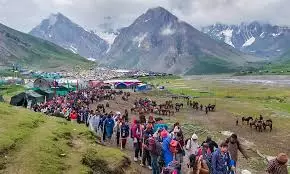Pahalgam, Baltal basecamps Welcome Amarnath Pilgrims

Pahalgam (J&K): Pahalgam wore a festive look as hundreds of Hindu worshippers received a warm welcome upon their arrival in the scenic Kashmir Valley’s premier resort on Friday, before their treading upon the mountain trails run northeast to the Amarnath cave-shrine.
Many of the devotees have assembled at Gauri Shankar temple to pay obeisance to Lord Shiva and his consort goddess Parvati whom it is dedicated to and warm up for the arduous journey through the rugged terrain to Amarnath.
Situated on the banks of gushing Lidder River, the Gauri Shankar temple like the nearby centuries-old Mamleshwar temple, also dedicated to Lord Shiva, become a major attraction during the annual Amarnath Yatra.
A group of saffron-clad sadhus, after praying at Gauri Shankar temple, took out a procession but, after covering less than 200 metres, returned to the sacred premises, chanting Bham Bham Bholey and other religious hymns.
The first officially-escorted convoy of a few hundred cars and buses carrying the pilgrims reached Nunwan, a base camp, about 3 km down the main town of Pahalgam late Friday afternoon. Another convoy of pilgrims has halted at a Yatri Niwas of the Shri Amarnathji Shrine Board (SASB) in Srinagar’s Pantha Chowk area before leaving for the Baltal base camp in Ganderbal district.
Earlier on Friday, J&K lieutenant-governor Manoj Sinha flagged off the first batch of Amarnath pilgrims from Jammu’s Bhagwati Nagar with the prayer: “May the blessings of Baba Amarnathj bring peace, happiness and prosperity to everyone’s life”. Mr Sinha extended his best wishes to all the pilgrims “for a safe, blessed, and spiritually enriching journey”.
The cavalcade of 231 light and heavy vehicles carried 4,603 pilgrims and was split into two escorted convoys -- one with 1,933 pilgrims bound for Baltal and the other with 2,670 pilgrims heading for Nunwan. Among the pilgrims, there were 3,631 males, 711 females, nine children, 237 sadhus and 15 sadhvis. Already, thousands of pilgrims are camping at Baltal, Srinagar, Nunwan, Pahalgam, Chandanwari and other places in Pahalgam area of Anantnag district and Ganderbal district to embark on the “journey of faith and devotion”.
Jai Kishan Pachauri, who has along with his mother, spouse and two children travelled all the way from Bhopal to visit the abode of “Bhole Baba” and have a darshan of the shivling, said: “The weather here is slightly hot and humid, but we are excited to be among the first to bow our heads to the great lord and seek his blessings.” He has found the arrangements made for the devotees’ journey “excellent”.
The 52-day-long annual pilgrimage to the Amarnath cave-shrine tucked away in Kashmir Himalayas at a height of 3,888 meters will officially begin on Saturday from both the traditional Pahalgam and shorter Baltal routes. The cave-shrine, the holiest of Hindu places of worship in north India, is at a one-day trek (14 km) from the base camp of Baltal, 96 km north of summer capital Srinagar, and at a three-day trek (34 km) from Chandanwari (Pahalgam), which
The officials of SASB, which manages the affairs of the yatra, expect more than half a million pilgrims to visit the cave-shrine during the pilgrimage, which ends on August 19, coinciding with “Shravan Purnima” (Raksha Bandhan). So far, 3.5 lakh pilgrims have registered for this year’s yatra, while the authorities have allowed the registration of intending pilgrims on arrival in Srinagar and Jammu as well
Tight security arrangements have been made for the yatra. Officials said that apart from deployments, a robust security cover has been put in place, which includes satellite and chip-based tracking of vehicles and pilgrims along the yatra routes, base camps and halt stations to ensure a smooth and incident-free pilgrimage. Drones, mobile bunker vehicles and road opening parties (ROPs) have been pressed into service for the purpose. Like last year, CCTVs have also been installed on the national highways, including NH44, to strengthen security and address traffic- related issues. Traffic restrictions are being imposed on various routes from June 28 to August 19, with daily advisories to minimise any kind of inconvenience, the officials said.
The J&K government has, as part of the “foolproof arrangement” for the smooth conduct of the event, involved almost all its departments and agencies in it. Interestingly, local Muslims traditionally play a major role in the conduct of the pilgrimage. They have set up hundreds of makeshift eateries and tea stalls, besides as many as 125 free langar or community kitchens laid by about 6,000 volunteers, mainly of voluntary groups and charities at Baltal, Chandanwari and Nunwun, and also at other halting places on the way to the cave-shrine.

